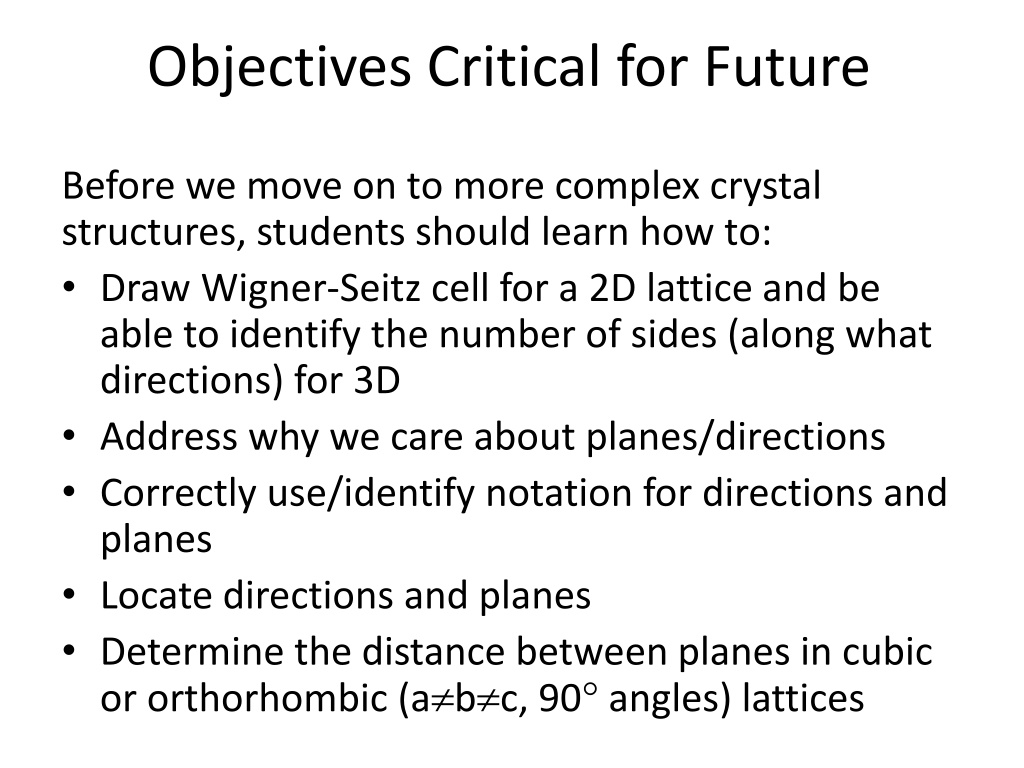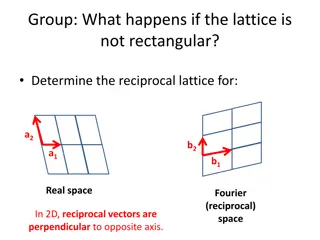Understanding Crystal Structures: Unit Cell Definition and Wigner-Seitz Method
Learn essential concepts such as drawing Wigner-Seitz cells, identifying lattice directions, using direction/plane notations, locating directions/planes, and calculating distances in cubic or orthorhombic lattices. Explore various ways to define a unit cell within a lattice, including the Wigner-Seitz method. Master these skills to pave the way for comprehending complex crystal structures.
Download Presentation

Please find below an Image/Link to download the presentation.
The content on the website is provided AS IS for your information and personal use only. It may not be sold, licensed, or shared on other websites without obtaining consent from the author. Download presentation by click this link. If you encounter any issues during the download, it is possible that the publisher has removed the file from their server.
E N D
Presentation Transcript
Objectives Critical for Future Before we move on to more complex crystal structures, students should learn how to: Draw Wigner-Seitz cell for a 2D lattice and be able to identify the number of sides (along what directions) for 3D Address why we care about planes/directions Correctly use/identify notation for directions and planes Locate directions and planes Determine the distance between planes in cubic or orthorhombic (a b c, 90 angles) lattices
Show me some ways that you could define a unit cell for this lattice.
There are many ways to define a unit cell. Here is one that will seem weird now, but will become important later. 1. Pick a center atom (origin) within the lattice
1. Pick a center atom (origin) within the lattice 2. Identify nearest neighbors (1st,2nd, 3rd to be safe)
1. Pick a center atom (origin) within the lattice 2. Draw perp. bisector to all neighbors (1st,2nd, 3rd to be safe)
1. Pick a center atom (origin) within the lattice 2. Draw perp. bisector to all neighbors (1st,2nd, 3rd to be safe)
Wigner-Seitz Method for Defining a Primitive Unit Cell (still applies in 3D) Always 6 sided in 2D, unless the lattice is rectangular. 1. Pick a center atom (origin) within the lattice 2. Draw perp. bisector to all neighbors (1st,2nd, 3rd to be safe) 3. Draw smallest polyhedron enclosed by bisectors
Wigner-Seitz Method for Defining a Primitive Unit Cell (still applies in 3D) This is NOT the Brillouin Zone. But, it will be related to something we call the first Brillouin zone soon! 1. Pick a center atom (origin) within the lattice 2. Draw perp. bisector to all neighbors (1st,2nd, 3rd to be safe) 3. Draw smallest polyhedron enclosed by bisectors
Group: Create Wigner-Seitz cell of the graphene lattice
Group: Create Wigner-Seitz cell of the graphene lattice
Determine the Wigner-Seitz cell for a simple cubic lattice a
Wigner-Seitz 3D cells For now, just a specific way to make up a unit cell. Is this BCC or FCC? Do these look familiar? BCC FCC # of nearest neighbors 8 12 # of second neighbors 6 6 Looks a little different in FCC. Why? How many sides does each have?
Crystal Direction Notation Choose one lattice point on the line as an origin (point O). Choice of origin is completely arbitrary, since every lattice point is identical. Then choose the lattice vector joining O to any point on the line, say point T. This vector can be written as; R = n1 a1 + n2 a2 + n3 a3 a1, a2, a3 often written as a, b, c or even x, y, z To distinguish a lattice direction from a lattice point (x,y,z), the triplet is enclosed in square brackets and use no comas. Example: [n1n2n3] [n1n2n3] is the smallest integer of the same relative ratios. Example: [222] would not be used instead of [111]. Negative directions can be written as Point T = (1,1,1) Figure shows [111] direction Also sometimes [-1-1-1] (nonideal) [ ] 1 n n n 2 3
Group: Determine the crystal directions X = -1 , Y = -1 , Z = 0 [110] X = 1 , Y = 0 , Z = 0 [1 0 0] [210] X = , Y = , Z = 1 [ 1] [1 1 2] X = 1 , Y = , Z = 0 [1 0] [2 1 0]
Group: Determine the Crystal Direction Now let s do one that s a little harder. X =-1 , Y = 1 , Z = -1/6 [-1 1 -1/6] [6 6 1] We can move vectors to the origin as long as don t change direction or magnitude.
Crystal Planes Within a crystal lattice it is possible to identify sets of equally spaced parallel planes, called lattice planes. The density of lattice points on each plane of a given set is the same (due to translational symmetry). A couple sets of planes in the same 2D lattice. b b a a
Why are planes in a lattice important? (A) Determining crystal structure * Diffraction methods measure the distance between parallel lattice planes of atoms to determine the lattice parameters (and other stuff) (B) Plastic deformation * Plastic deformation in metals occurs by the slip of atoms past each other. * This slip tends to occur preferentially along specific crystal-dependent planes. (C) Transport Properties * In certain materials, atomic structure in some planes causes the transport of electrons and/or heat to be particularly rapid in some planes, and relatively slow in other planes. Example: Graphite: heat conduction is strong within the graphene sheets.
Miller Indices (h k l ) for plane notation (no comas) Miller Indices represent the orientation of a plane in a crystal and are defined as the reciprocals of the fractional intercepts which the plane makes with the crystallographic axes. To determine Miller indices of a plane, take the following steps: 1) Determine the intercepts of the plane along each of the three crystallographic directions 2) Take the reciprocals of the intercepts 3) If fractions result, multiply each by the denominator of the smallest fraction (multiply again if needed to get smallest possible ratio)
1) Determine the intercepts directions Example-1 2) Take the reciprocals of the intercepts 3) If fractions result, multiply Axis Intercept points Reciprocals 1/1 1/ 1/ Smallest Ratio 1 X Y Z 1 0 0 Miller ndices (100) (1,0,0) Crystal Structure 19
1) Determine the intercepts directions Example-2 2) Take the reciprocals of the intercepts 3) If fractions result, multiply Axis Intercept points Reciprocals 1/1 Smallest Ratio X Y Z 1 1 1/ 0 1/1 1 1 (0,1,0) Miller ndices (110) (1,0,0) Crystal Structure 20
1) Determine the intercepts directions Example-3 2) Take the reciprocals of the intercepts 3) If fractions result, multiply Axis Intercept points Reciprocals 1/1 Smallest Ratio X Y Z (0,0,1) 1 1 1 1/1 1 1/1 1 1 (0,1,0) Miller ndices (111) (1,0,0) Crystal Structure 21
1) Determine the intercepts directions Example-4 2) Take the reciprocals of the intercepts 3) If fractions result, multiply Axis Intercept points Reciprocals 1/( ) 1/1 1/ Smallest Ratio 2 X Y Z 1/2 1 1 0 (0,1,0) (1/2, 0, 0) Miller ndices (210) Crystal Structure 22
Group: Example-5 1) Determine the intercepts directions 2) Take the reciprocals of the intercepts 3) If fractions result, multiply Axis Intercept points a b c 1 1/ 1/1 1/( ) Reciprocals Smallest Ratio 1 0 2 Miller ndices (102) Note change of axis orientation Can always shift the plane (note doesn t make a difference)
Group: Example-6 Yes, I know it s difficult to visualize. That s actually part of the point of doing this one. Axis Intercept points a b c -1 1/ 1/-1 1/( ) Reciprocals Smallest Ratio -1 0 2 Miller ndices (102) (102)
What are the Miller Indices (h k l plane and the direction perpendicular to it? h k l) of this 3 2 , 2 , a b c [2 3 3] Plane intercepts axes at 1 1 1 2 , , Reciprocal numbers are: 3 2 2 c Indices of the plane (Miller): (2 3 3) b 2 a Indices of the direction: [2 3 3] 3 Miller indices are still used for a non-cubic system (even if angles are not at 90 degrees)























